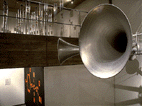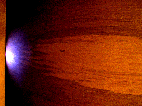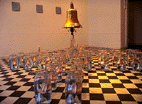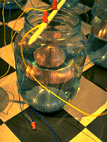| |
Listening
in
Melissa
McMahon bugs
Nigel Helyer
|
| |
|
| |

Nigel
Helyer, Silent Forest,
multi-source sound installation
in two parts + accompanying radio
broadcast. Exhibited San Francisco
Art Institute as part of
SoundCulture 96.
|
|
Nigel Helyer is an
English-born, Sydney-based sound artist, lecturer at
Sydney College of the Arts, and co-founder of
SoundCulture, a Pan-Pacfific organisation focusing on
sound art. Helyer's work is of an essentially composite,
or in his words "pluridisciplinary", character,
in the sense that not only does any given piece
incorporate a range of media, but many are part of a
series of "events" (one or several?) including
other pieces, other artists, other countries, radio
broadcasts, internet links, CD's, and CD-Roms. In
Australia he most recently featured as one of the 5
finalists of the new Contempora 5 art competition, now
Australia's largest (in monetary terms) art prize, the
winner receiving A$100 000 over two years, this year
awarded to Fiona Hall. Helyer's piece, Silent Forest
was acquired by the National Gallery of Victoria and,
somewhat controversially, publically received a personal
commendation by Victoria's Premier and Arts Minister,
Jeff Kennett. The harder you listen, the less you
hear. The harder you listen, the less you hear and the
more you find yourself an instrument in a soundscape.
Listening to a voice, when transcribing an interview for
example, the less you hear what is said and the more you
find yourself immersed in a parallel drama of breath,
tone, speed and slowness, a series of peculiarly intimate
yet not quite human events, disturbing the flow of what
we want to hear and want to say. Sound seems to have a
special kinship with the affective interruption of an
event, with the incidental, in two senses: this amorphous
rustling or, at the other end of the spectrum, the
officious abruptness of an air-raid siren or a radio
broadcast. Did you hear the news? In Helyer's Silent
Forest, inspired by the empty imperialist edifice of
the French Opera House in HaNoi topped by air-raid
sirens, the sound artist runs over the spectrum,
selecting and creating a new bandwidth, a new fabric from
these rents:
|
| |
|
NH: |
"In the sound
piece, for [Silent Forest], you have the kind of
wail of the siren, you have fragments of Vietnamese
instruments tuning up, which often have that wail as
well, so they're formally quite similar, and then you
have out-takes of fragments of Western art music, kind of
heavily reconstructed digitally... and the final sort of
element in that sequence is recreating the sounds of a
kind of forest, in that sound that swirls around
overhead. Now those sounds were all taken from very early
archival recordings of real environments, of rainforests
and things from South-East Asia and Australia, but they
were taken from '78's, which were so old and degraded
that what happened was we actually stripped the signal
out of them, and left the artefact, the needle noise, the
scratching, the blips and cracks, and then remixed that
into a kind of rustling, which actually sounded like a
forest - although someone thought it was the
ocean..." |
| Between the two poles are any number of combinations
whose reverberations shape, orient and combine the
private and public, the silent (un-heard) and the
announced. There is a constant preoccupation in Helyer's
work and in his conversation with the notion of
situation, and while Helyer has described himself as a
"sound-sculptor", a better way to approach
perhaps the relation between the visual and aural
components of his work is if we consider them as the work
of an architect: |
| |

Nigel
Helyer, Oracle, installation
with multi-channel audio and
video components, timber, audio-visual
electronics, low frequency audio
drivers, 4 units @ 3m x 2m x 3m, 1995.
|
NH: |
"The
thing about sound is that it doesn't travel throughout
the universe, it's kind of locally bounded and it's
locally produced. It's incredibly site-specific in that
sense, so you and I talking in this room are sounding
differently than we would in any other room, although
we'd say the same things... Through acoustics you
actually sense volume, texture and configuration... I'm
acutely aware, when I go into a space, of listening to
the space, and I can tell you, you know, what kind of air
conditioning there is andwhat kind of surfaces that the
building's made of and so on and so forth... I always
want to maintain that idea of a balance between the
physical, palpable and vibrating or resonant source, and
the actual, you know, content of the sound, it's kind of
very much the medium is the massage, er, message...
" |
| |
|
|
At the same time, while sound gives an
immediate sense of a specific situation, it can also blur
its internal coordinates, the frequencies of
communication preceding the physical and personal
boundaries from the perspective of the inhabitant. This
psychical blurring is a frequent theme in Helyer's
writing, and feeds into his preoccupation with the
possibilities of a collectivised "public
space", for which he draws inspiration from such
disparate sources as South-East Asian streetscapes and
Gothic cathedrals: |
| |

Nigel
Helyer, Toll, Located in
two sites. The Muu Galerie, Helsinki,
Finland and at the Cholera Basin,
Helsinki Harbour (October 1996),
x2 Bronze Bells, x32 Voltaic cells
and electronic circuits, audio
equipment with ISDN telephone line,
Zinc wall texts, 6m x 6m, Harbour
installation, variable.
|
NH: |
"I
think that [in relation to] a notion of public space,
it's sort of silly to think about space as a physical
thing, and it's really much more to do with transactions
and transmissions and flows and circulations and
exchanges, and so I think work which deals with those
things, or encourages those things, allows those things
to happen in a multiple way, is actually really
interesting work, and I mean, how you do that is kind of
a) hard to imagine and b) very plural solutions I think
are needed for it. Cathedrals were market places for a
long time, and there were all sorts of weird things that
happened in them... As I child I used to sing in one, as
a choir boy, and there's an incredible experience of that
sort of reverberant space where the voices literally kind
of fold around everybody, but also the kind of active
situation of being one of the kind of little fleshy
things that produced that sound, and I think being in a
choir is one of those really transforming experiences,
and I think that's probably one of the things that I find
that a lot of people don't understand, because I don't
think people go through those type of experiences in
contemporary kind of situations enough, people aren't
collectivised at that kind of level... There are very few
places, like Sydney and Melbourne, which even have a
sense of civic space and centres, where people do feel to
be part of some kind of civic collective, and all the
political rhetoric is obviously against that - to
privatise, to dismantle the public. But in a sense it's
only those collective experiences that allow us to
understand things beyond ourselves, so yeah, it's kind of
strange, I kind of think of myself as being an almost
medieval character. I think there is quite a difference in
some cultures of feeling that public space is still a
viable situation as a kind of a vis-a-vis between people,
and that there is more possibility for a kind of
expression, or in fact there's almost an imperative that
somehow expression takes place... The last time I lived
in South-East Asia for 6 months, when I came back I think
was in a state of shock for 2 weeks, I was trying to find
where the people had gone to, because the streets were
empty, and the only people you saw were in vehicles, and
it was a kind of silence or emptiness."
|
| |
|
|
It is again, on a different level, the
"homelessness" of sound as an artistic medium
or discipline which is a point of attraction for Helyer: |
| |
 Nigel
Helyer, Toll, Located in
two sites. The Muu Galerie, Helsinki,
Finland and at the Cholera Basin,
Helsinki Harbour (October 1996),
x2 Bronze Bells, x32 Voltaic cells
and electronic circuits, audio
equipment with ISDN telephone line,
Zinc wall texts, 6m x 6m, Harbour
installation, variable.
|
NH: |
"In being part
of the sound culture thing, this pan-Pacific
organisation, we've had these sort of discussions about
the theoretical and historical status of "sound
art", in inverted commas, and the fact that there
isn't really one, there isn't really a history, no one's
really written it, it doesn't live anywhere, I mean sound
exists as a sort of subset of almost every discipline you
can think of, like engineering or architecture or dance
or whatever, they all have their relationship to sound,
but sound is somewhere in the basement, somewhere, and it
also, in a sense it sort of flows between everything, and
so I tend to think of it as a kind of connective tissue
that sort of joins things together, and a lot of the
discussion has actually been that it's actually an
incredibly positive thing that it doesn't live anywhere
in particular, and that no one actually has kind of
pegged and staked the territory, because it leaves it in
a sort of fairly productive, mobile, if not slightly
anarchistic sort of state...it's not deregulated, it
never was regulated in the first place." |
| |
|
|
At the same time, there is nothing formally
"anarchistic" about Helyer's work, which on the
contrary is striking for it's clean and polished surfaces
and finely-tuned technical and technological finish. All
qualities which, as if by contagion, were regarded with a
kind of suspicion at the moment Helyer became "the
artist who shook hands with Jeff Kennett". Helyer
likes the anecdote that "if you are a computer
company, or if you are a nasty government agency, and you
wanted to find out what you could actually do with a
computer, you'd give them to music students, and they
would do all the kind of R&D work for you, innocently
thinking they were creating culture, in fact what they're
doing is road-testing your technological device." Helyer
notes that "you can drive that equation in a fairly
critical way", but the point of complicity is
reversible: perhaps the "nasty government
agency" "innocently" thought they were
road-testing their technological device when "in
fact" they were creating culture. It's in terms of
an "incidental" overlap between disparate
agendas that Helyer considers the meeting of the artist
and the establishment in the context of such events as
Contempora 5:
|
| |
|
NH:
|
"It's sort of
what you would call, like in a sort of sound studio, an
"artefact", artefacts are the products of the
recording process, so like needle noise is an artefact
for example, and in a sense things like competitions in
the art world, they are in a sense artefactual, they're
separate from the process of creativity... and in a sense
they're conceived of as being separate from even the
market place although I suppose they do have a kind of
relationship to it, so what I'm trying to say I suppose
is that they're an entirely artificial situations, and
they're designed for particular reasons, they're designed
to draw media attention, and so they have an agenda which
is entirely outside a kind of creative realm... I don't
know what goes on inside [Jeff Kennett's] head, and I
would imagine he liked it for reasons which were entirely
different from my intentions. So be it."
|
| |
|
|
On the one hand Helyer emerges as a
somewhat medieval figure again, a meticulous and
dispassionate artisan: |
| |
|
NH:
|
"In a sense I
think of my practice, and always have done, in quite
detached terms, I mean, I'm not an artist who works in a
particularly autobiographical way, and I don't see myself
as an expressive sort of artist, I don't necessarily use
my personal psychology to produce work. I certainly use
my personal experience to produce work, but I think of it
much more as a sort of production, I think of myself as a
very small production company. In some ways I think it's a sort of
red herring, the whole issue [of a conflict between art
and technology], because if you think about medieval
culture, the mixing of oil paint was probably one of the
most technically complex things, or the casting of bells,
was probably one of the most technically complex things
that were done during that period, and I mean, it's a
sort of truism but: artists have always worked with
technology, and they've always had a very strong interest
in technological edges. I certainly don't believe that
artists are the people who develop it, I think artists
are quite often sort of the dumb followers of science,
but what artists seem to be... the position they seem to
take are as people who actually critique
technology."
|
| |
|
|
On the other the technical attention of the artisan
blends with a portrait of the artist as one who creates
and critiques not through direct refusal of environmental
givens, but through a process of constant testing,
refining, listening: |
| |
|
NH:
|
"One of my
strong interests has always been in the idea of a
relationship between a world of poetics and a world of
technics, and that in our culture they're seen as very
separate things, whereas I think I've kind of... grown up
almost, thinking they were the same thing, I mean,
growing up in a kind of post-industrial Britain, or sort
of being kind of fairly familiar with industrial
archaeology, like ruined primary industry sites and
things like that. I've sort of always seen technology,
and especially the sort of heavy end of technology as
part of a culture. I suppose I feel like I've always had
a kind of critical relationship to it, and that's been a
thematic interest, and not much in a kind of refutation
of it, but more as a kind of acceptance of it, as an
inevitable part of a cultural fabric. My first day at art school is
actually a good example of, probably, why I'm the way I
am. I remember that the first thing that actually
happened when we got to our home base or our studio, is
we had to undo our Stanley knife, get the blades out, the
new blades, and sharpen them, because they simply weren't
sharp enough, we were told, and I thought that was a very
interesting thing, and that really stuck in my mind, that
things could always be a bit sharper, literally and
metaphorically, and that you shouldn't simply, you know,
you don't just walk into the hardware store and buy the
blade and use it, you think about the blade and you
think, well, is it actually adequate for the job, and
often it isn't, and that goes for computer programmes,
the lot, you know."
Melissa McMahon
October 1997
© The artist and 
Courtesy of the artist.
|